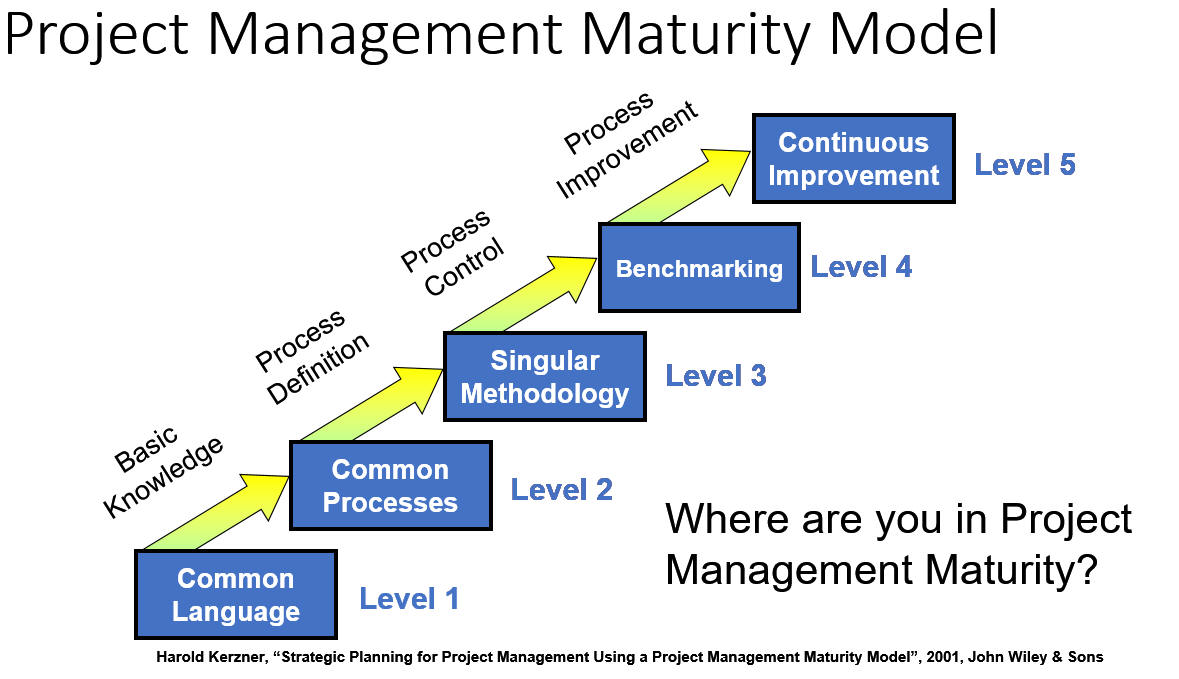Services / Maturity Models
Previous / next: Microsoft 365 Training
Using a Project Management Maturity Model (PMMM) to maintain competitive advantage
What is a Maturity Model?
A maturity model is a tool that helps an organisation or team to achieve required benefits from following a desirable best practice behaviour, approach or methodology (“the goal”).
Examples of a behaviour, approach or methodology could include:
- Leadership,
- Team productivity,
- Change management,
- Project management,
- Software development.
How does a Maturity Model work?
A maturity model consists of a series of levels, from low to high maturity and a roadmap to achieve the desired level of maturity.
The maturity model approach uses qualitative data to enable the organisation or team to review the desirable goal and understand:
- How they are currently performing.
- What they have to do to improve this performance and reach the goal of their desired ‘maturity’ level.
What is a Maturity Model level?
A maturity model level is a logical staging post on the way to ‘maturity’.
Reaching a specific maturity level allows the organisation or team to pause and reflect on the journey so far, and plan for the next level of improvements to help them on their way to achieving their desirable goal.
Competitive Advantage
Competitive advantage is the set of factors or capabilities that allows companies to consistently outperform their rivals whilst enjoying sustained levels of high performance.
However, for many organisations, survival and prosperity are also linked to their ability to effectively compete in an increasingly global market.
Doldrum Bay Consulting believe that by improving a company's overall maturity in the field of project management (especially around delivering change through technology), companies can positively influence their competitive advantage and better compete in a global market.
Project Management Maturity Model
There are many project management maturity models available. The majority are based on the Software Engineering Institute’s “Capability Maturity Model” (CMM) [Carnegie Mellon Software Engineering Institute, 1993].
The model chosen by Doldrum Bay Consulting came from Harold Kerzner who has written several books on the subject [Kerzner, 2001, Kerzner, 2003].
In his book, “Strategic Planning for Project Management Using a Project Management Maturity Model”, Kerzner developed a model for measuring the maturity of an organisations project management processes and procedures, along with the ways of improving that maturity [Kerzner, 2001]. The model is shown below.
The Kerzner Project Management Maturity model is like the CMM in that both define five levels of maturity, with the theory that the higher the level of maturity, the better the overall project management performance.
The movement between the different levels is not necessarily a sequential process. Some of the levels can overlap. However, each must be completed in the order given. For example, level 1 (common language) and 2 (common processes) can overlap, but level 2 cannot be completed before level 1 is complete [Kerzner, 2001: 43].
White paper
For more details see the white paper: "Competitive advantage using an organisational project management maturity model: is this achievable?"
References
Carnegie Mellon Software Engineering Institute (1993): Capability maturity model for software. Carnegie Mellon University. Retrieved 27 May 2017, from https://www.sei.cmu.edu/reports/93tr024.pdf
Kerzner (2001), “Strategic Planning for Project Management Using a Project Management Maturity Model”, John Wiley & Sons
Kerzner (2003), “Project management: a systems approach to planning, scheduling, and controlling”, John Wiley & Sons
